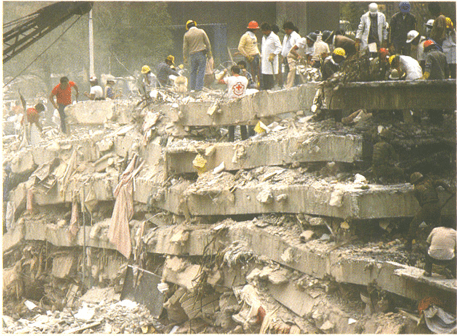“It is 7:19 am with 32 seconds central Mexico Time. It is still shaking a little, but let’s remain calm and wait a second so we can—…” These were the last words the people of Mexico City heard from Lourdes Guerrero, the face of Televisa’s morning news before their televisions cut to static. The next ninety seconds would not only change Mexico City forever but it would define a whole generation’s governmental standards.1
For the people of the Mexican capital, Thursday September 19, 1985 began like any other day. It was 53 degrees; the sky was clear, and at just a little after 7:00 am, children were arriving at schools, adults were going to work, and the city was beginning to wake up for another day.2 Suddenly at 7:19 am, the worst earthquake to ever strike the city unleashed on the Mexican people, and for ninety seconds, the capital experienced the full force of mother nature. Measuring 8.1 on the Richter scale, the earthquake moved whole concrete buildings and crushed entire apartment complexes, effectively trapping the people inside.3

Prior to the arrival of the Spaniards in 1521, the Aztecs had built their capital, Tenochtitlan, over Lake Texcoco. “Over the years, this man-made island has paid the price for building over a lake with soft soil. Every year since its establishment, Mexico City has been steadily sinking into the fragile soil,” and when earthquake waves arrive in the areas around the city, they are amplified by a factor of 100, causing the damage to be worse than it would be in any other soil.4 On the morning that terror struck, Mexico City felt the magnitude of an earthquake that developed off the coast of Michoacán. The earthquake waves reached the capital with a magnitude of 8.1 on the Richter scale, but created much greater damage than any other earthquake before.5
After the earthquake, the citizens began to assess the damage and the long and difficult road towards recovery. Almost instinctively, they started moving rocks and debris from people and liberating some who were trapped.6 Within hours, the citizens noticed the poor response from the government, especially from president Miguel De la Madrid, who had not publicly spoken about the tragedy. As the day went on, the number of people missing increased as well as the impatience of the citizens as police and the military were unable to get organized and froze, leaving the relief efforts completely in the hands of the citizens.7
In the north of the city, the General Hospital had lost its entire OBGYN (obstetrician and Gynecology) wing, trapping mothers who had just given birth as well as their new born babies. Sylvia Reyna, a nurse working at the hospital, gave her testimony about how doctors, nurses, and anyone who was willing to help rushed to start looking for survivors. “Every time someone got out alive, we cheered and celebrated with happiness, but when we pulled a lifeless body, everyone was silent.”8 Scenes like this one were not isolated. All throughout the city there was more than 100,000 homes and buildings destroyed by the earthquake that ultimately trapped people inside. Famous city landmarks, like the famous Regis Hotel and the country’s most important television network headquarters, had been crushed, ultimately cutting the city’s most important form of communication with the outside world. Although the death toll for the first day is still unknown, many believe the number is in the tens of thousands.9

With over 250,000 people left without a home, and no response from the government, the citizens united to take over the search and rescue to find those who were missing.10 Women brought pots and pans and cooked for the volunteers, doctors and nurses created makeshift hospitals to treat the injured, and crime was controlled by the citizens. The first 24 hours after the earthquake put incredible pressure on the government to respond, and as media outlets around the world started spreading the news of the earthquake, the pressure put on the president was raised.
Without the government’s assistance, various groups like the now famous Topos de Tlatelonco formed in order to help dig out people. Although nowadays the Topos are an established organization famous for their heroic assistance all around the world, in 1985 they were just a citizen-based group volunteering to help the people still trapped inside the buildings. During the terrible earthquake in 1985, these men and women earned the nickname “topos,” which means “moles,” for their incredible ability to go into the rubble to help those inside. Today, more than thirty years after the tragedy in Mexico City, this official organization has traveled all across the world to help in disasters, such as the earthquake in Haiti in 2010, and the Tsunami in Indonesia of 2004.11
The progress of the initial day was incredibly inspiring as hundreds of people had been rescued and the city was united to overcome the terrible tragedy. However, they were not prepared for the 7.1 magnitude aftershock that arrived 36 hours after the initial quake. On the evening of September 20, as many citizens dug in the ruins of apartment complexes and wandered around the city looking for their loved ones, the capital was struck with another earthquake that completely halted the recovery and forced many to start over. The aftershock made the buildings that had earlier collapsed settle, which made it much harder to rescue those who were still trapped. Although the damage from the second quake was incalculable, the second earthquake left citizens more afraid and scared than the first one. Citizens once again flooded the streets and dropped to their knees to pray for it to stop.12
With yet another earthquake, and pressure from his people, President Miguel De la Madrid first spoke publicly about the earthquake three entire days after the initial earthquake happened. His response outraged the citizens as De la Madrid downplayed the number of injured and dead in front of the world media and refused to accept aid from countries around the world who offered to help.13 One of his initial responses was also to send the military and police to disrupt the progress citizens had made by blocking off many buildings and restricting access to volunteer groups such as the Topos de Tlatelonco. By doing so, he effectively stopped the search and rescue of hundreds of individuals who were still trapped and injured days after the quake.14 His actions only angered the people more, and many citizens recalled the soldiers actively looting in the ruins of hotels and apartment buildings, taking all the safe boxes and jewels they could find.

Although the exact death toll was never given, some estimate it to be between 10,000-40,000.15 In the aftermath of the historic earthquake, the government was forced to implement building safety codes and regulations as well as an early-earthquake alarm system to ensure people will get out of structures safely. Similarly, after incredible pressure from citizens and other countries, Mexico ultimately accepted help from the United States, insuring that people would receive the much needed help. Nowadays in Mexico City and in the surrounding municipalities, people continue to regularly practice evacuation. Schools and offices hold earthquake drills regularly to ensure the events of 1985 won’t happen again.
The citizens did their best to move on, and return to normalcy as soon as possible. Despite living among the incredible destruction, they went to mass, they returned to work, they began reconstruction and prayed for those who were still missing. Now more than thirty years after the terrible events brought the capital to its knees, the damaged areas show no evidence of the destruction, with only monuments left to remind them of the tragedy that took place.16
- Encyclopedia of Latin American History and Culture, June 2008, s.v. “Earthquakes,” by Jürgen Buchenau. ↵
- “Weather history for MMMX Thursday September 19, 1985,” Weather underground, Accessed April 12, 2018. https://www.wunderground.com/history/airport/MMMX/1985/9/19/DailyHistory.html?&reqdb.zip=&reqdb.magic=&reqdb.wmo=. ↵
- Elena Poniatowska, Nothing nobody: the voices of the Mexico City Earthquake (Philadelphia, Temple University press, 1995), 13. ↵
- Michael Kimmelman, “Mexico City, parched and sinking, faces a water crisis,” The New York Times (New York City, NY), February 17, 2017; Lucy Jones, interview by Judy Woodruff, PBS News Hour: Why Mexico City is vulnerable to earthquakes, September 20,2017. ↵
- Historical Dictionary of Mexico, 2008, s.v. “Earthquake of 1985,” by Marvin Alisky. ↵
- Alan Riding, “A year after the quake, Mexico City Is on the mend,” The New York Times (New York City, NY), September 20, 1986. ↵
- Daniel Hernandez, “The 1985 Mexico City Earthquake, Remembered,” Los Angeles Times, September 20, 2010. ↵
- Elena Poniatowska, Nothing nobody: the voices of the Mexico City Earthquake (Philadelphia, Temple University press, 1995), 19. ↵
- Encyclopedia of Urban Studies, 2010, s.v. “Mexico City, Mexico: History of the city,” by Adrian Guillermo Aguilar and Ailasa Winton. ↵
- Encyclopedia Britannica, September 20, 2017, s.v. “Mexico City earthquake of 1985.” ↵
- “Historia,” Brigada de rescate Topos de Tlatelonco, accessed April 10, 2018. http://www.topos.mx/nosotros/historia. ↵
- Rosalía Guerrero, interview by Guillermo Guerrero, La replica del 20 de Septiembre de 1985, Chilango, September 18, 2015. ↵
- Elena Poniatowska, Nothing nobody: the voices of the Mexico City Earthquake (Philadelphia, Temple University press, 1995), 24. ↵
- “El Universal,” Miguel De La Madrid, El Presidente ‘ausente’ En Tragedia Del 85 | Red Política – El Universal. September 19, 2004. Accessed April 13, 2018. http://www.redpolitica.mx/nacion/miguel-de-la-madrid-el-presidente-ausente-en-tragedia-del-85. ↵
- Alan Riding, “A year after the quake, Mexico City Is on the mend,” The New York Times (New York City, NY), September 20, 1986. ↵
- David Adler, “The Mexico City earthquake, 30 years on: have lessons been forgotten?,” The Guardian (Mexico City, Mexico), September 18, 2015. ↵



47 comments
Genesis Moro Otero
I really loved this article on how well written it is. The earthquake itself is a tragic natural disaster in history. It is sad but at the same time heartwarming, to know now how the Mexicans came all together to help each other. I couldn’t believe that the government’s response to this was awful, how they opposed the efforts for help that the civilians had already begun. The author really displayed the horror that came with this natural disaster.
Juliana Montoya
The earthquake of 1985 was a very tragic even for the country of Mexico and it is very saddening to read about how bad the impact was on its people. Though the actual tragedy is devastating it is still inspiring to read about how so many people wanted to come together and fix what the earthquake had done.
Hector Membreno
This is one of the best articles i have read on this website yet!! This article is both sad and motivating at the same. The actual earthquake is extremely sad and it nothing short of an catastrophe. But the way that the people of Mexico city rallied together to help people is amazing. The way that they formed groups such as Topos de Tlatelonco is incredible that they are now helping people around the world.
Kenneth Gilley
What a great article! The 1985 Mexico City earthquake was definitely one of the most devastating natural disasters in history. The government’s response to the tragedy was unthinkable. I cannot believe that the government actually impeded the rescue efforts that brave civilians had begun. At least some good came out of the earthquake: improved building codes and early warning systems. The author did an excellent job of presenting the horror of this disaster.
Rebeca Escobar
A very tragic event that cost thousands of lives and demonstrated the meaning of community and coming together as one. How the Mexicans came together to help everyone out is truly inspiring. I can’t imagine not having a leader/president to offer guidance and reassurance. It’s sad that De la Madrid refused outside help and his men even stole from the people.
Fatima Navarro
I wasn’t born until 6 years later after this earthquake, but it didn’t matter if you were alive during the earthquake or not, you would still know what happen and always remember it. This earthquake shaped Mexico city so much, it changed so many things and it made the people of Mexico to come up with better infrastructures for future earthquakes. After this earthquake, every year there are drills during this time because of it that way people in Mexico are more educated in what to do if another earthquake of this magnitude was to happen.
Matthew Swaykus
The author did a good job highlighting the hardships, fear, and outraged cause in the wake of this disaster. It is unthinkable that these events could take place, especially on the part of the Mexican Government. I imagine the President of Mexico forever lives in reviled infamy for the actions he took and the lack of care the bureaucracy had for its citizens.
Yazmin Garza
The sense of community among the victims of the earthquake is so amazing, and it shows the bond that people share in these types of situations. I can not believe the president was so negligent of his own people, and that the ‘relief’ forces he sent to help did the exact opposite of that. De la Madrid was foolishly prideful when he declined foreign aid and the people of Mexico City deserved someone who their job seriously and protected and helped them when they needed it. It is heartbreaking to think about how this tragic event basically repeated itself a few years ago. I hope it never happens again.
Eric Ortega Rodriguez
This was a very well written article. I remember my parents talking about this earthquake and how devasting it was for the citizens of Mexico. I was also surprised to read how long it took the Mexican government took to respond to the incident. I am glad to see that there were so many citizen volunteers and that the United States was able to help Mexico during this time, it shows that all countries and people should help one another in their time of need. Great article.
Alexandra Lopez
This article was well written and informed the reader about the aftermath of that horrible earthquake that had occurred in Mexico City. It is terrifying that one minute you are reporting the news or walking down the street and then suddenly one of worst earthquakes in your country’s history hits. In a city as large as it is, it had a devastating effect. (reposted)